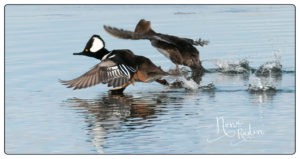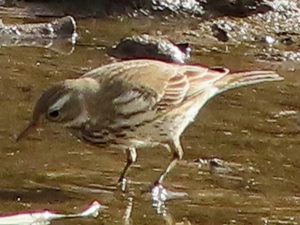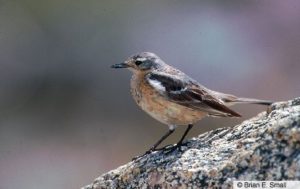Another fun-filled bird walk with mild winter weather! Yahoo! We started at the pond immediately north of the Front Range Birding Company along Remmington Ave. Here, we got good close looks at a slew of Cackling Geese, a variety of ducks, and two individuals that I want to spend a bit more time on. First, we had a Belted Kingfisher, that I misidentified as a first-year bird. There were two things wrong with that assessment. First of all, there are no juvenile kingfishers in mid-winter as they have acquired their adult plumage by October – I just didn’t think it through properly. Second of all, I was wrong about what I thought I saw with regard to our bird’s plumage.
So, let’s get straight about Belted Kingfishers. The male has a single gray upper breast-band, the female has the same gray band as the male PLUS a second rusty-colored breast-band lower down and a bit of the same rusty coloring in the flanks, and the juvenile is just like the female except the rusty breast-band is broken in the middle and does not extend all the way across. In looking at the photo you can see that our bird was an adult female. The second bird I want to bring to your attention was a hybrid Common Goldeneye x Hooded Merganser. Though rare, these guys do occur with some regularity.
We then spent the majority of the morning visiting various ponds in the vicinity of South Platte Park. Among the highlights were several pods of Northern Shovelers swirling around and creating a vortex to bring food up to the surface of the water. We also saw an interesting convocation of over forty Buffleheads in one group. And, we had great looks at a male American Kestrel, our smallest falcon.
Our group began to dissipate around eleven o’clock, and several folks missed out on one of the more interesting birds of the morning – an American Pipit. These small, slender, migratory birds are rather inconspicuous looking, occurring throughout North America and as far south as El Salvador. They belong to an elite group of ground-inhabiting songbirds that breed in both alpine and arctic tundra, and here in Colorado they can be a fairly common summer resident above timberline. In the winter, though, they are rather uncommon, being found occasionally along sandy shorelines of ice-free rivers, which is exactly where our bird was on Saturday.
Back to the appearance of the American Pipit. David Sibley, well-known ornithologist and author/illustrator of many bird fields guides, has described the American Pipit as possibly “the most variably-colored songbird on the continent.” This does not mean a lot of bright colors, just that within their inconspicuous subtle coloring there is a lot of variation. Some of this can be ascribed to differences between the four main subspecies of American Pipit, which can generally be distinguished from one another based on the amount of yellow vs pink on the breast and belly, the darkness vs lightness of the legs, the extensiveness and boldness of the breast streaking, and the whiteness of the supercilium (eyebrow) and maIar (whisker). In looking at the two photos here, our Saturday bird had faint yellow on the belly, bold streaking on the breast, and strikingly white supercilium and malar, making it I believe a member of the eastern subspecies (Anthus rubescens rubescens), while the other picture shows a Colorado breeder with hardly any of the characteristics mentioned above, making it a member of the Rocky Mountain subspecies (Anthus rubescens alticola). However, I’m getting way over my head here, and haven’t even mentioned seasonal molt differences. Finally, Sibley contends that much of this variation could simply be due to differences between individual birds.
What a nice engaging pastime it is trying to always learn just a little bit more about our avian friends.
See you on another walk soon!
Chuck
South Platte Park, Feb 1, 2020
29 species
Cackling Goose 500
Canada Goose 30
Northern Shoveler 200
Gadwall 12
American Wigeon 8
Mallard 39
Green-winged Teal 26
Ring-necked Duck 17
Lesser Scaup 16
Bufflehead 60
Common Goldeneye 34
Hooded Merganser 17
Common Goldeneye x Hooded Merganser (hybrid) 1
Common Merganser 4
Pied-billed Grebe 1
Rock Pigeon 16
Killdeer 5
Ring-billed Gull 5
Great Blue Heron 1
Bald Eagle 1
Red-tailed Hawk 4
Belted Kingfisher 3
Northern Flicker 2
American Kestrel 1
Black-billed Magpie 1
American Crow 8
Black-capped Chickadee 2
American Pipit 1
House Finch 4
Red-winged Blackbird 2







Comments
Write Comment